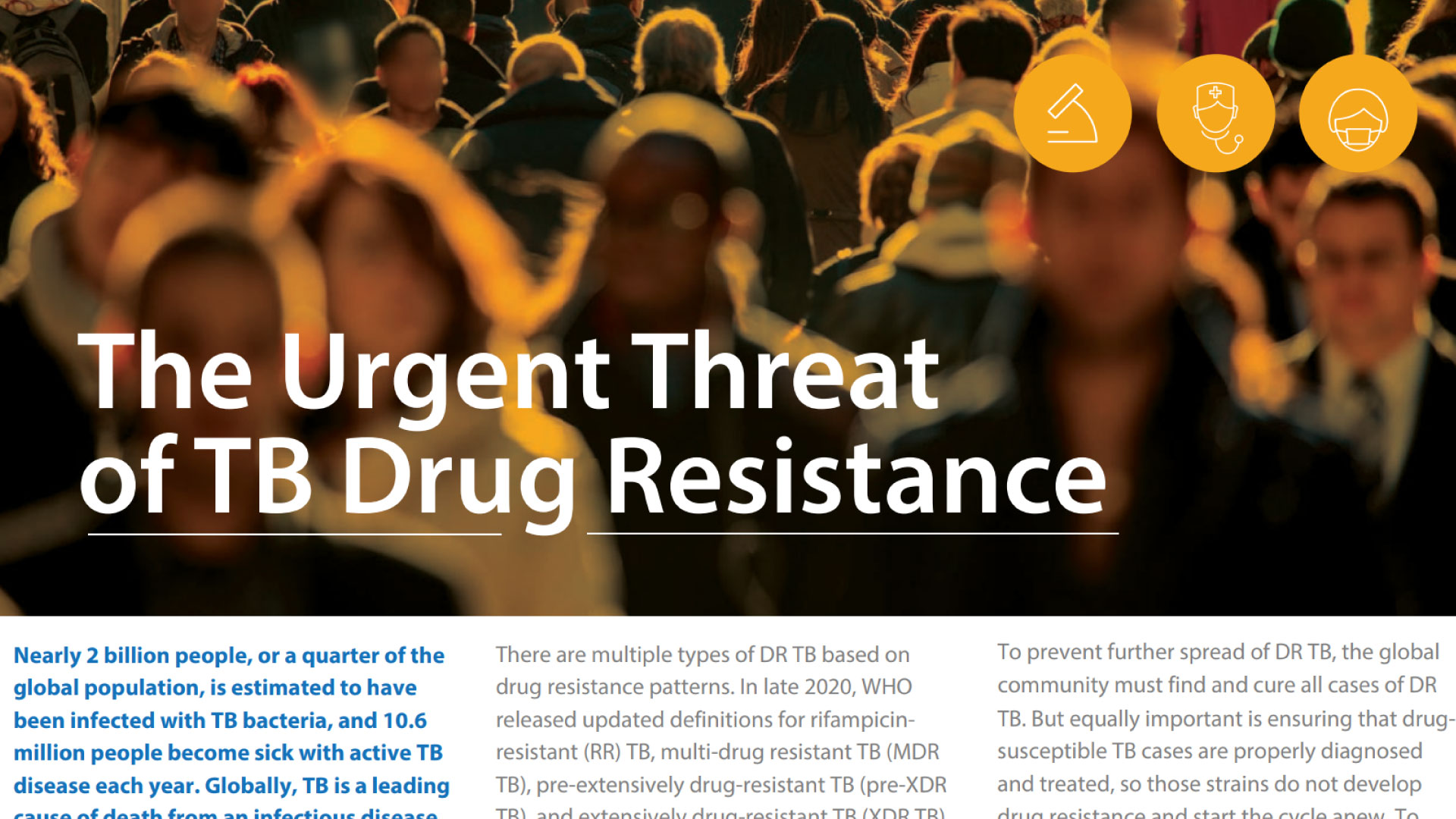508 text
The Urgent Threat of TB Drug Resistance
Nearly 2 billion people, or a quarter of the global population, is estimated to have been infected with TB bacteria, and 10.8 million people become sick with active TB disease each year. Globally, TB is the leading cause of death from an infectious disease, claiming 1.25 million lives in 2023, even though a TB cure has existed for more than 70 years. Fortunately, TB is preventable and curable, so the global community can end TB if existing tools in all affected countries are implemented at scale.
In some cases, the bacteria that cause TB infection can develop resistance to drugs used for TB treatment. Most often, this stems from incomplete treatment of drug susceptible TB. In recent decades, drug-resistant strains have continued to spread globally. Drug-resistant TB (DR TB) strains are often more difficult to diagnose and cure and costly to economies and health systems.
There are multiple types of DR TB based on drug resistance patterns. In late 2020, WHO released updated definitions for rifampicin-resistant (RR) TB, multi-drug resistant TB (MDR TB), pre-extensively drug-resistant TB (pre-XDR TB), and extensively drug-resistant TB (XDR TB), which have progressively broader drug resistance and often poorer treatment outcomes with fewer medicines available for treatment. New breakthroughs in DR TB treatment mean that all oral treatment regimens, as short as six months, are available for DR TB now.
TB is airborne and contagious, so the continued spread of DR TB could cause a resurgence of TB in parts of the world where TB is currently less common, including the United States. This is why CDC responds to TB at home and abroad to create a safer America and a safer world.
To prevent further spread of DR TB, the global community must find and cure all cases of DR TB. But equally important is ensuring that drug-susceptible TB cases are properly diagnosed and treated, so those strains do not develop drug resistance and start the cycle anew. To stop DR TB, the global community must get back to the basics of effective TB prevention and treatment.
The time is now
In 2023, an estimated 400,000 people became sick with MDR-TB or rifampicin-resistant TB (RR TB) around the world, and recent estimates suggest that 150,000 people lost their lives due to MDR/RR TB. MDR TB is resistant to isoniazid and rifampicin, the two most common anti-TB drugs, and it has been reported in virtually every country in the world, and XDR TB has been reported in over 100 countries. If the global community does not act to contain these strains, DR TB will remain a public health crisis and a health security threat.
DR TB is harder to find, treat and cure
Drug-resistant TB is harder to diagnose
- Requires laboratory tests not easily accessible to patients and some countries have limited capacity for testing.
- Often requires weeks to months to diagnose accurately.
- Only 2 in 5 people in need of DR TB treatment were diagnosed and started on treatment in 2023.
- In 2024, only 14% of the estimated 30,000 children with MDR/RR TB were diagnosed and initiated treatment.
Drug-resistant TB is harder to cure
- Treatment for DR TB often takes longer and may be more complicated to cure than drug-susceptible TB.
- DR TB drugs are sometimes more toxic than drug-susceptible TB drugs and may have a higher risk of causing side effects.
- Just 68 percent of people who were started on MDR TB/RR TB in 2023 were successfully treated.
CDC is a leader in the response to DR TB
CDC is committed to achieving global targets for ending all forms of TB by 2035. To address DR TB, CDC works with partners including other U.S. Government agencies and ministries of health to:
Diagnose
- Strengthen laboratory networks and surveillance systems to enable rapid, accurate diagnosis of all TB, including DR TB cases.
- Develop innovative approaches to find TB in all forms.
Treat
- Work closely with WHO to set the gold standard for treating DR TB.
- Expand access to newer, shorter treatment regimes that cure patients faster and with fewer side effects.
Prevent
- Ensure appropriate treatment of all TB cases to prevent resistance.
- Break the cycle of transmission through infection prevention and control.
- Scale up TB preventive treatment and antiretroviral therapy for people living with HIV to prevent TB disease.
Eliminating DR TB worldwide
This is a critical point in the response to TB and DR TB. TB notifications were the highest in history in 2023, pointing to improvements in TB diagnosis. However, drug-resistant strains of TB continue to spread with a potential to grow more resistant to treatment if left unchecked. This may lead to a future where TB is no longer curable, which could result in a substantial increase in TB-related deaths.
The availability of shorter, all oral regimens for all forms of DR TB is very promising and can be a game-changer in the management of DR TB. Efforts to end TB reap $40—by 2050—in return for every $1 invested. Investing in ending TB, including DR TB, has benefits that extend beyond TB by bolstering health systems, preparing the world for the next pandemic of another airborne pathogen, and reducing the global burden of antimicrobial resistance.
- Diagnose and treat all existing cases of DR TB
- Scale-up tools to find and cure all forms of TB
- Strengthen basic TB control programs to prevent drug-resistant strains from developing

